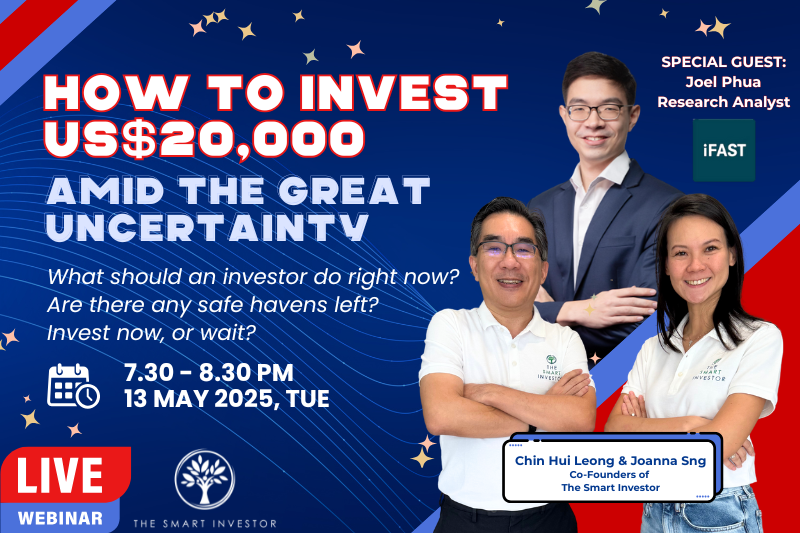If you’ve ever fretted over the topic of retirement, you’re not alone.
Singapore is known for being one of the most expensive cities in the world.
Property prices have continued their ascent even amid the COVID-19 pandemic, rising 2.9% in the first quarter of this year.
Meanwhile, saving cash alone may not be enough.
Inflation is also constantly eating away at the value of our savings, eroding it over time like sandpaper.
A recent survey by Manulife Singapore found that close to two in three Singaporean retirees regret not planning earlier for retirement.
Only 25% of this group had a retirement plan, while 33% had to continue working post-retirement to increase their savings.
Having insufficient savings and passive income is not a situation any of us would like to be caught in as we approach our silver years.
There are steps you can take, though, if you plan to retire comfortably.
Here are three actions you can take to position yourself for a worry-free retirement.
1. Start investing
If you haven’t already done so, you should start investing as early as you can.
By investing your money, you can grow it slowly and steadily to end up with a comfortable nest egg by the time you are ready to retire.
Parking your money in large, well-established companies means you can have peace of mind that they can survive through multiple crises.
For those who are young and just starting their careers, growth investing can help your wealth to grow above the rate of inflation.
The important thing is to start as soon as possible as money left in the bank will earn sub-par rates of return.
Of course, you need to get your personal finances in order before you even invest your first dollar.
Don’t invest money that you need for big-ticket items such as a house, marriage or car.
Also, do ensure you have sufficient savings for emergencies and that you are properly insured.
2. Build a passive income stream
The next step is to steadily build up a portfolio of solid dividend-paying stocks.
Dividend investing is an effective way to start building up your stream of passive income.
Real estate investment trusts, or REITs, are a reliable source of dividend income as they need to pay out 90% of their earnings as dividends.
These are also non-REIT companies that have a long track record of paying increasing dividends through thick and thin.
Proctor and Gamble (NYSE: PG), 3M (NYSE: MMM) and Kimberly Clark (NYSE: KMB) are some of the companies that have increased their dividends over decades.
Blue-chip companies that can pay out sustainable dividends should also be added to your watchlist.
The local banks such as DBS Group (SGX: D05) and OCBC Ltd (SGX: O39), as well as Singapore Exchange Limited (SGX: S68), are great candidates for regular, consistent dividends.
As you deploy more funds over time into such dividend-paying companies, your passive income flow will also increase in tandem.
3. Harnessing the power of compounding
As you pump more money into dividend-paying companies, you should start receiving an increasing flow of dividends into your bank account.
The key to growing your wealth lies in one simple word: compounding.
Simply put, compounding is a process by which you reinvest the dividends you receive into the same companies that are paying these dividends.
The power of this process cannot be understated.
Imagine this simple scenario: if you are receiving $500 a year from your $10,000 investment in dividend stocks, that’s a 5% dividend yield.
But if you reinvest this $500, then your investment base increases to $10,500.
Assuming the dividend yield stays constant, you will receive $525 in dividends the following year.
And if you are also making regular additions to your dividend portfolio, this investment base will grow even further and yield even higher levels of dividends.
If you inject an average of $500 a month, you will end up adding $6,000 to your investment portfolio after one year, increasing your base to $16,500.
Applying a 5% dividend yield means your annual dividend now increases to $825.
Get Smart: It’s easier than you think
Investing requires both discipline and patience, but it’s much easier than you think.
All you need to do is devote the time and energy to start your investment journey as soon as possible.
Start deploying money into solid businesses and I guarantee you will relish the dividends that flow in.
With time as your friend, compounding can then work its magic and grow your money into a large nest egg for you to retire comfortably.
By then, you would also have built up a sizable investment sum in dividend-paying stocks that can sustain you with passive income during your golden years.
Want a sweet combination of dividends and growth from your stock portfolio? Download our latest special FREE report, 8 Singapore Stocks for Your Retirement Portfolio HERE. We cover eight blue chips and mid-cap companies that we believe can ride the recovery and offer investors a great mix of both growth and income. Click HERE to download for FREE now!
Follow us on Facebook and Telegram for the latest investing news and analyses!
Disclaimer: Royston Yang owns shares in DBS Group and Singapore Exchange Limited.




